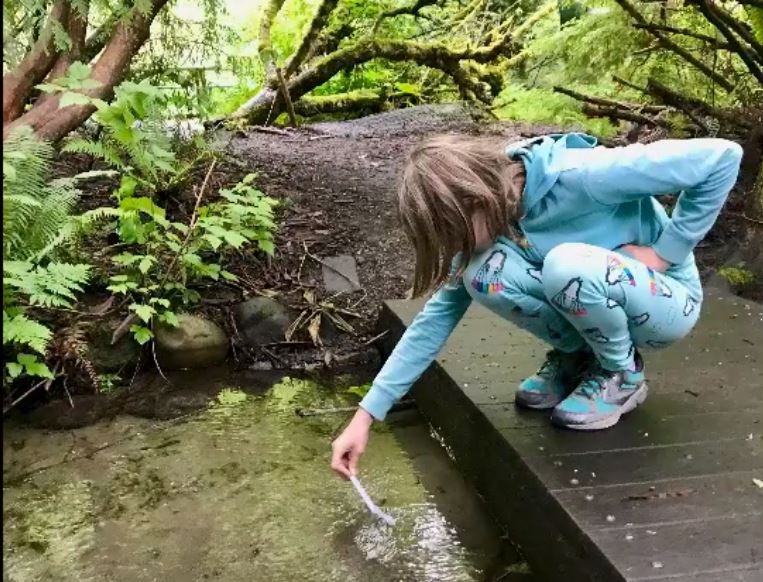Tacoma Public School students are taking a big step into their local ecosystem.
While the pandemic has disrupted in-person schooling nationwide, Tacoma Public Schools is piloting a new Explore the Salish Sea science curriculum district-wide that adventurous fifth grade teachers at two Tacoma schools implemented last year.
Explore the Salish Sea is an education program of the SeaDoc Society — a marine science organization based on Orcas Island and a program of the Karen C. Drayer Wildlife Health Center at the University of California, Davis. The curriculum is built on the book of the same name, authored by SeaDoc Society Science Director Joe Gaydos and board member Audrey Benedict.
Mira Lutz Castle, SeaDoc Society education coordinator, developed the curriculum with input and direction by marine scientists, tribal members, and classroom teachers throughout the region. It is being implemented not only in Tacoma, but also throughout the Salish Sea, which encompasses the Puget Sound, the San Juan Islands and the waters off of Vancouver, British Columbia.
“Driven by their own curiosity and imaginations, the kids engage in solving mysteries in the sea nearby,” said Castle. “They take the helm to uncover clues, following the real process of science with support of scientists and traditional knowledge holders in their own communities. It brings the village together around the kids and benefits wildlife, people and the whole community.”
Hands-on curriculum
Inspired by Mary Lyon Elementary School, which built Salish Sea elements into their new school design and integrated Explore the Salish Sea book pages into their playground equipment, Castle held her first educator workshop in Tacoma in 2018 — the first of many throughout the region.
The workshops allowed teachers, marine educators, scientists and tribal leaders to come to the table and help shape the learning process. The result is a hands-on curriculum aimed at sparking wonder and curiosity, and encouraging young people to actively engage with their home ecosystem.
Mary Lyon Elementary and Sherman Elementary schools were the first to implement the curriculum, specifically with units on killer whales, water quality, and salmon health, survival and reproduction.
“We must educate students about their environment if we expect them to have a positive impact on it,” said Kimberly Wagoner, fifth grade teacher at Mary Lyon Elementary. “My students were engaged and excited to learn that these things are ‘in their backyard.’”

Helping students see science
The curriculum soon caught the eye of Tacoma Public Schools instructional facilitator Ryan Patterson, who worked with Castle to bring the Explore the Salish Sea curriculum into every fifth grade classroom throughout the district.
“One look at the beautiful book and I was sold!” said Patterson. “Helping students see science in their local habitat helps foster curiosity and encourage actions that will help make a difference. While this year has been just a little challenging, we are excited to see how we can embed more learning experiences through the lens of the Salish Sea.”
When the coronavirus pandemic arrived, schools were transformed into remote operations with students connecting via laptops at home. It also meant in-person teacher-training workshops needed to go on hold.
With a grant from the Mitsubishi Corporation, Castle provided class sets of Explore the Salish Sea: A Nature Guide for Kids books to 2,400 Tacoma students and developed an online multimedia training course to allow the district’s 90 fifth-grade teachers to learn the curriculum and how to implement it remotely. That training is now live, and Tacoma educators are completing it at their own pace.
From killer whales to salmon recovery
The infrastructure and technology are in place for this year’s students to find solutions to challenges faced by southern resident killer whales through engineering ocean technology and supporting salmon recovery. Fifth graders will replicate last year’s salmon study in Swan Creek, only this year it will involve the whole district and an all-star cast of expert community partners.
Students will work to solve the mystery of why coho salmon aren’t surviving to spawn in nearby urban streams, whether their local Swan Creek is safe for coho fry, and if so, where is the best site to release their fry.
The effort is made possible by community partners, including Foss Waterway Seaport, housing coho fry and conducting the water-quality testing; Metro Parks Tacoma, providing vegetation surveys and drone footage; and Pierce Conservation District, which is collecting macroinvertebrates that serve as pollution indicators and salmon snacks.
“We’re not telling them the results,” said Castle. “We’re showing them! They’ll see drone footage of each stream site, color charts for water quality, macroinvertebrates wiggling in bins, the amount of shade provided by trees — and they’ll document the findings in their journals and graphing programs.”
Students will make evidence-based arguments about where to release their fry, and they will make science and traditional knowledge-based recommendations for salmon enhancement actions. Thanks to Mitsubishi Corporation and community partners, students will take those actions — from planting native plants and removing invasive ones, to building rain gardens with Orcas Love Raingardens — and create a public outreach art installation on salmon and orca recovery at the Seaport Museum this spring.
“In their new curriculum, the fifth graders are the engineers, scientists, artists and citizen caretakers of our shared Salish Sea — hopefully for a lifetime,” said Gaydos.
Media Resources
Justin Cox, UC Davis School of Veterinary Medicine/SeaDoc Society, 530-219-5227, jcox@ucdavis.edu
Kat Kerlin, UC Davis News and Media Relations, 530-750-9195, kekerlin@ucdavis.edu